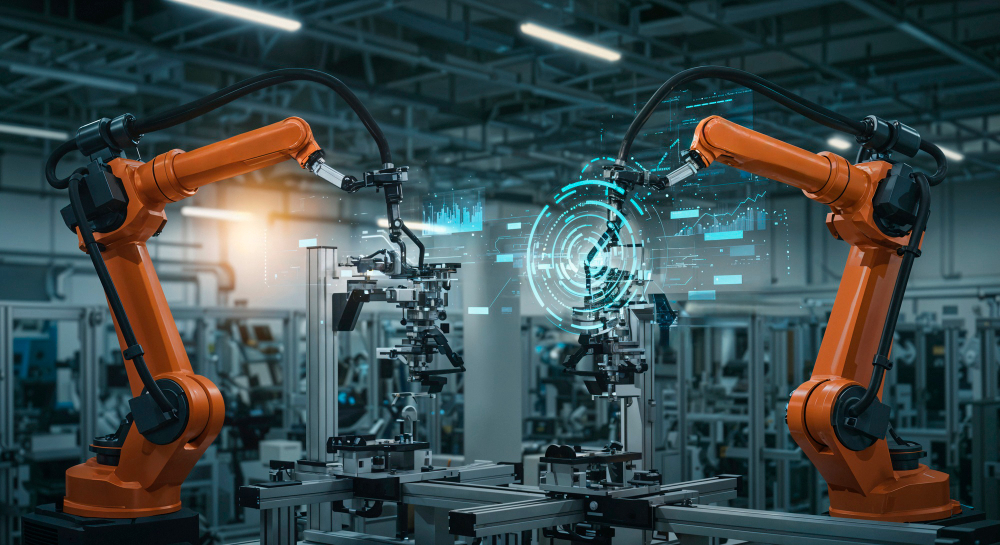Introduction
The term “smart factory” represents the future of manufacturing—where machines, data, and AI work together to optimize production. At the heart of this transformation lies AI in manufacturing, which powers intelligent decision-making, autonomous operations, and continuous optimization. In this blog, we’ll explore how AI plays a central role in smart factories and how it’s driving productivity, efficiency, and innovation in the industrial sector.
What Is a Smart Factory?
A smart factory is a highly digitized and connected production environment that relies on technologies like artificial intelligence (AI), machine learning, IoT (Internet of Things), and robotics. These elements enable factories to make real-time decisions, automate workflows, and adapt to dynamic market demands with minimal human intervention.
AI in manufacturing gives these factories the “brains” to go beyond automation—making them truly intelligent systems that can learn, adapt, and optimize on their own.
1. Real-Time Process Optimization
Smart factories operate with dozens (if not hundreds) of interconnected systems. AI enables manufacturers to analyze this continuous stream of data in real time to make immediate improvements.
By using machine learning algorithms, AI can:
-
Detect performance bottlenecks
-
Automatically adjust machinery settings
-
Optimize production schedules
-
Reduce cycle times
Example:
GE uses AI-powered analytics across its smart manufacturing facilities to reduce waste and improve yield on high-value components like jet engine parts.
2. AI-Driven Predictive Maintenance
Unplanned equipment failure is a major cause of downtime and revenue loss. In smart factories, AI solves this with predictive maintenance. Using real-time data from IoT sensors, AI algorithms can forecast machine health and alert technicians before a failure occurs.
Benefits include:
-
Reduced maintenance costs
-
Higher uptime
-
Extended asset life
-
Fewer production disruptions
Example:
Hitachi leverages AI to monitor factory machinery performance in real time, achieving significant reductions in maintenance costs and downtime.
3. Autonomous Production Systems
One of the most futuristic yet increasingly real aspects of smart factories is autonomous production—systems that monitor, adjust, and control manufacturing without human input. AI enables this by interpreting data and making on-the-fly decisions to maintain product quality and efficiency.
Autonomous systems can:
-
Adapt production lines to new product specs
-
Self-correct errors
-
Maintain optimal throughput levels
Example:
BMW’s smart plants use AI-based autonomous systems for paint quality control, adjusting application methods in real-time based on environmental conditions.
4. Enhanced Quality Assurance with Computer Vision
Smart factories rely on AI-powered visual inspection systems for quality control. These systems use high-resolution cameras combined with AI algorithms to detect even the most microscopic defects.
This process is:
-
Faster than manual inspections
-
More consistent
-
Scalable across multiple production lines
Example:
Foxconn uses computer vision for inspecting microchips and electronics, which significantly boosts accuracy while reducing human error.
5. Energy Optimization and Sustainability
AI contributes to sustainability efforts by optimizing energy consumption. Smart factories equipped with AI can monitor real-time energy usage and recommend changes to improve energy efficiency.
Key areas of improvement include:
-
Load balancing
-
Equipment shut-off automation
-
Emission tracking
-
Predictive cooling/heating adjustments
Example:
Schneider Electric’s smart factories use AI to automate energy management, achieving up to 30% energy savings across their global operations.
6. Supply Chain and Logistics Integration
AI in manufacturing extends beyond the factory floor. Smart factories use AI to manage and optimize supply chains through real-time forecasting, route optimization, and inventory control.
AI helps:
-
Predict supplier delays
-
Manage just-in-time inventory
-
Automate procurement decisions
-
Optimize shipping and logistics
Example:
Tesla’s gigafactories integrate AI systems that align production with supply chain inputs, reducing material waste and increasing responsiveness.
7. Workforce Augmentation with AI-Enabled Tools
Rather than replacing workers, AI enhances human capabilities through intuitive, intelligent systems. In smart factories, workers use AI-powered dashboards, augmented reality (AR) tools, and digital assistants to make better decisions, faster.
AI helps human operators by:
-
Providing actionable insights from complex datasets
-
Recommending workflow improvements
-
Reducing cognitive load
Example:
Airbus equips its factory teams with AR headsets that use AI to guide assembly tasks, improving accuracy and reducing rework time.
Benefits of AI in Smart Factories
AI enhances the smart factory model in several critical ways:
| Benefit | Impact |
|---|---|
| Real-time analytics | Immediate issue detection and resolution |
| Higher efficiency | Optimized processes and reduced waste |
| Customization at scale | Fast adaptation to new products or design changes |
| Reduced operational costs | Predictive and energy-efficient systems |
| Faster decision-making | Data-driven strategies for every layer of operations |
Challenges and Considerations
While AI brings tremendous value, implementing it within smart factories presents some challenges:
-
High initial investment: Infrastructure, hardware, and software costs can be significant.
-
Data security: Increased connectivity introduces cyber threats.
-
Workforce reskilling: Operators must learn to interact with AI systems.
-
Integration with legacy systems: Connecting AI tools to older machinery requires effort and expertise.
Overcoming these challenges requires a strategic roadmap, starting with pilot projects and scaling gradually with clear ROI tracking.
Conclusion
AI in manufacturing is no longer optional for companies that want to thrive in the era of smart factories. From real-time optimization and predictive maintenance to energy management and supply chain intelligence, AI empowers manufacturers to be faster, smarter, and more resilient.
Smart factories are not just about automation—they’re about transformation. And AI is the engine driving that change. As technology matures and adoption grows, those who invest in AI today will define the next generation of industrial success.
Are you ready to transition to a smart factory model powered by AI? Now is the time to evaluate your systems and embrace the intelligent future of manufacturing.
